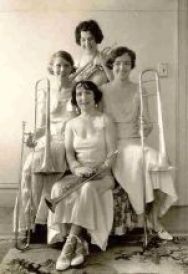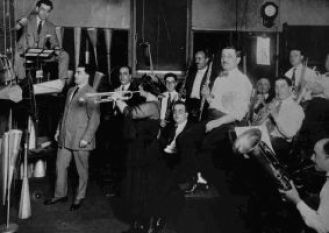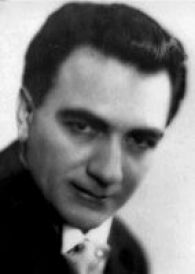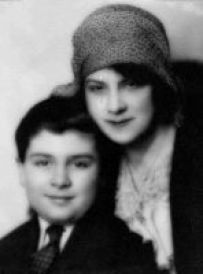EDNA WHITE (October 23, 1892 - June 25, 1992) Trumpeter, composer, authorOne of the foremost trumpet soloists in the first half of the 20th Century.Right: Publicity photo for her first cornet solo in Carnegie Hall, 1901 Far right: Publicity photo for her trumpet recital in Carnegie Hall on February 19, 1949 | 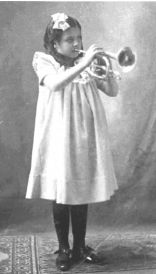  | 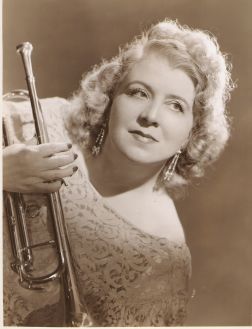  |
1892 -- 1914 A Child Prodigy |
1892 Prices |
A child prodigy on cornet, Edna White was born in 1892 in Stamford, Connecticut. Her father, Herbert J. White, was an amateur cornetist. On her seventh birthday, he gave her a cornet and taught her the C scale. She quickly learned to play every song she knew. Recognizing her extraordinary talent, her father moved the family to Brooklyn, NY. Herbert joined an amateur band. Edna was the featured soloist for their concert in Carnegie Hall on May 3, 1901, (publicity photo above) for which she received $25. She was not yet nine years old. That summer she was hired as soloist for a popular summer resort in Ocean Grove, NJ, and quickly gained fame as a child prodigy. [1, 2] | Bread .03/loaf Milk .18/gal Average income: $635/year Bicycles were the most popular form of transportation. All entertainment was live, in theaters, traveling circuses, minstrel and wild west shows, including Buffalo Bill's. President William McKinley was assassinated in 1901. VP Theodore Roosevelt became president. |
In 1904, Dr. Frank Damrosch recruited her to study at his newly founded Institute of Musical Art (now called Julliard). There, a month before her 12th birthday, her professional training began in earnest. Her teacher, Adolphe Dubois, principal trumpet with the NY Philharmonic, switched her from cornet to trumpet, and predicted a brilliant artistic career for her. (see his endorsement below in "Mentors") [1]
At the 1907 commencement, Edna was the only graduate to play a solo, but she received no degree because she was too young, an oversite rectified in 1984 when a Julliard representative awarded her an Artist's Diploma. [4] |
Edna formed an all-woman trumpet quartet, and the Redpath Chautauqua Company hired them to tour the country (1910-1912). But after disagreements with the other women, Edna went home to her family in Indianapolis. There, at her mother's urging, she married Myron Chandler, a man almost twenty years her senior in 1913. (photo at right) Myron Chandler and Edna White Myron disapproved of her trumpet playing and urged her to study voice. Edna refused and insisted they return to New York so she could resume her career. [1] | 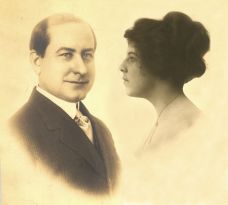  |
1914 -- 1918 A World War |
But WW I was raging in Europe. In 1917 the United States declared war against Germany. Nearly 10 million men registered for the draft. Millions of women filled the jobs they left behind, working as auto mechanics, streetcar conductors, and on factory assembly lines.
For the first time, women joined the U.S. military. More than 11,000 enlisted in the Navy, working as stenographers and clerks. [3] One was Catherine Woodward, pictured in uniform at the far right with two of her yeoman-F mates in 1918 at the Naval base in New London, CT. Below: A WWI submarine moored at the Groton, CT, Naval base where Catherine was stationed. [Author collection] |   |
  | |
In 1914, Myron's foreign bank accounts were frozen. Edna formed a trumpet quartet and became the breadwinner.
The Edna White Trumpeters played at the 1915 Panama Pacific Exposition in San Francisco, (photo right), prior to an appearance by famed evangelist preacher Billy Sunday. Edna also played a trumpet solo with the Mexican National Band. [1]
But in 1916, pregnancy interrupted her career. Her son, Douglas Chandler, was born in 1917. Edna doted on him, but the marriage, doomed from the start, crumbled, and Edna left Myron in 1918. [1] |   |
The 1920s Happiness and Success |
To support herself and her son, Edna formed a brass quartet: Edna and Julie Golden played trumpet. Velma Howell and New England Conservatory graduate Ida Bisbee played trombone. Photo at right, Edna stands at the rear; Ida Bisbee seated on the right.
Highly successful, the Edna White Brass Quartet toured vacation resorts and the Keith vaudeville circuit throughout the 1920s, and Ida Bisbee later married Edna's only brother. The 1920s decade was a successful time for Edna. In 1920 she made her first recording for Thomas Edison, playing Herbert L. Clarke's The Debutant. [1, 2] Hear Edna play The Debutante |
|
Between 1920 and 1926, she recorded for Edison and Columbia records, as a trumpet soloist and later as a duo with the new man in her life, operatic baritone Torcum Bezazian. At right: Edna and Torcum in Edison's NYC studio. Note the hat! After Edna's divorce from Myron became final in 1923, she married Torcum (photo below), who became a de-facto father to her son Douglas. (pictured with Edna below) She and Torcum formed a vaudeville act, Bezazian and White, and toured the Keith-Albee circuit as headliners for much of the decade. |
|
In her book, The Night the Camel Sang, Edna marks this as the happiest period of her life. In 1927, they took Douglas to France to visit Torcum's mother. Then a stunning development sent Edna's life spinning into turmoil. Torcum decided to stay in France to further his operatic career. But Edna's only career opportunities lay in the U.S. She made a wrenching emotional decision and sailed back to New York with Douglas, and without Torcum.
|
|
|
Edna resumed her career as soloist and leader of her brass quartet. But after the stock market crash in 1929, people rushed to banks to withdraw their money. The banks closed, and millions of people, including Edna, lost their life's savings. [5] | ||
The 1930s and the Depression |
The 1930s brought difficult times for Edna. The Depression all but killed vaudeville, her main source of work, and a bout with scarlet fever led to heart problems. In her memoirs she recalled that she and Douglas, whom she called Buddy, "subsisted for days on hard-boiled eggs." She played a few concerts with all-women orchestras led by Antonia Brico (NY) and Ethel Leginska (Boston). John Phillip Sousa heard her solo with Henry Hadley's Manhattan Symphony, deemed her "a most gifted soloist," and asked her to solo with his band, but he died soon thereafter. In 1938, she played Rimsky Korsakov's Flight of the Bumblebee on the WOR-NY radio program "Famous Firsts." [1] |
The 1940s and 1950s: A spectacular success and a farewell recital |
During the 1940s, Edna performed infrequently: a tour with the American Women's Symphoniette in 1941, a solo appearance with Ethel Stark's Montreal Women's Symphony in 1944. After graduating from college, Douglas advised her to spark her career with a solo recital. She agreed and at the age of 57, she prepared a challenging program. Her Carnegie Hall recital on February 19, 1949 included works by J.S. Bach, Georges Enesco, Canadian composer Gena Branscombe, and the premier of At the Beach, a concert waltz composed for her by Virgil Thomson. Conrad V. Bos accompanied her on piano. [1] Publicity photo at right By all accounts, it was a spectacular suceess.
|   |
The New York Times critic praised her "musicianship, good sense of pitch and powerful, brilliant tone." [6] The Herald Tribune review noted: "Miss White is a real virtuoso and the very first to give a trumpet recital in Carnegie Hall. There seems nothing she cannot attain with her instrument." [7] Bandmaster Edwin Franko Goldman deemed the recital a "triumphant success" and her playing "very fine indeed," praising her lovely tone, precise intonation and phrasing. [1] The reviews brought a flurry of work: a performance on the CBS TV show We the People, a 37-week tour of military hospitals, two solo appearances with the Goldman band in New York City. After extended correspondance with composer George Antheil, Edna premiered his Trumpet Sonata at Columbia University in 1954. One of her few performances in the 1950s. In 1957, at the age of 65, she returned to Carnegie Hall to play her "farewell recital," which included the Carnival of Venice. [1] | |
Hear Edna play the Carnival of Venice | |
1960s, 70s and 80s Reteirement? Not really! |
The word "retirement" was not in Edna's vocabulary. For a time she did PR for Rinn Records, and in 1963 (at age 71!) she was associate editor of Boxing World, writing feature articles and a weekly column. In 1968 she moved to Greenfield, MA, to be near her son, but Douglas died in 1970, leaving her grief stricken. [1]
In 1992 I met Edna at a nursing home in Greenfield, MA. Then 99 and in failing health, she remained clear headed and ambitious, enthusiastically discussing her plans to write another book. Sadly, before completing it, she died on June 25, 1992. At her memorial service, I met many of her relatives. My deepest gratitude goes to Edna's niece, Cynthia (White) Dixon, her husband Tom Dixon, and Edna's nephew Edward White, for entrusting me with Edna's personal and professional papers. I have placed them at the Sibley Music Library at the Eastman School of Music, University of Rochester (NY), for the use of researchers. | ||
For a comprehensive biography of Edna White, including many more photographs, see WOMEN WHO DARED See a three minute video about Edna's life and career! Her historic recordings are available here |
COMMENTARY MENTORS: In 1904, her trumpet teacher Adolphe Dubois gave this written testimonial: "I am happy to testify to the real talent of my pupil, Edna White. Although but fourteen, she is already a brilliant performer. To a very original expression, she adds a truly remarkable technique." This opinion was seconded in writing by Julliard founder, Dr. Frank Damrosch, who offered continued encouragement and support throughout her career. [1 ] IMPORTANT COLLABORATIONS: Torcum Bezazian, with whom she recorded and toured the vaudeville circuit, and the women in her brass quartet, most notably trombonist Ida (Bisbee) White, her sister-in-law. Later in life, her family was steadfast in their support of her many projects. Other friends and supporters included Vincent Bach, conductor Antonia Brico, and composers Virgil Thomson, Gena Branscomb and Georges Antheil. Trumpeter Louis Davidson said of her when she was 95: "... her mind operates at 100 miles per hour every waking minute of every day." [1, 2] GENDER ISSUES: Despite her obvious talent, Julliard training and glowing endorsements from her trumpet teacher and others, her career path was limited. Had she been able to win an orchestral position, she might have gained financial security, but the few women hired by orchestras prior to the 1970s were string players. Her only opportunities were with all-woman groups, her brass quartet, or as a soloist, in vaudeville, or with orchestras or concert bands with no women members.
Consider these firsts: in 1957 (when Edna was 65) trumpeter Leona May Smith was the first to be hired (as an extra) by the Metropolitan Orchestra; in 1964 Marie Speziale was the first trumpeter to win a position in a major orchestra (Cinncinnati Symphony); not until 1973 did a major symphony (St. Louis) hire a woman, Susan Slaughter, as principal trumpet. [9]
HER LEGACY: Edna's keen intelligence, musical talent and indomitable will led to her many achievements. At a time when most women stayed home to raise children, indeed, before women had the right to vote, Edna defied convention by choosing a career playing the trumpet, then considered a man's instrument. In later years, her work was recognized by many prominent musicians. Unfortunately, wider fame and financial security eluded her, hindered as she was during her prime playing years by a music world that devalued (and rarely hired) female brass players. |
Milestones and Honors: Edna's age in parentheses
1901 (9): Plays cornet solo at Carnegie Hall with concert band. 1904 (14): Completes music studies at Julliard. 1902-1909 (age 9-17): Soloist at a summer resort in Ocean Grove, NJ. 1910-1930 (age 18-38): Leads and performs in several all-woman brass groups. 1920s (age 28-38): Records for Edison and Columbia records. Stars in vaudeville with Torcum Bezazian. 1934 (42): Plays first broadcast performance of Flight of the Bumblebee, WROR-NY radio 1949 (57): First trumpeter ever to play a solo recital in Carnegie Hall, favorably reviewed in the NY Times and the NY Herald Tribune. 1954 (62): Premiered George Antheil's Trumpet Sonata at Columbia University 1957 (65): Plays "farewell recital" in Carnegie Hall 1980 (88): Suite for Solo Trumpet and Orchestra, premiered in Greenfield, MA 1981 (89): The Suite is recorded by Gaeton Berton and the Maryland Theater Orchestra 1984 (92): Belatedly awarded Diploma from Julliard 1985 (93): The Suite is performed in Carneigie Hall, Richard San Filipo, trumpet soloist 1990 (98): Publishes The Night the Camel Sang, a book about vaudeville |
Edna White Discography Edison Records: as trumpet soloist: The Debutante (Herbert L. Clarke), and Recollections of 1861-1865, 1920 Bluebells of Scotland (arr. J. Levy), 1921 When You and I Were Young, Maggie, (Butterfield), 1925 Then You'll Remember Me (Balfe), and Sweet Genevieve (Tucker), 1926 Sempre Libre from Traviata (Verdi) 1926 With Torcum Bezazian: Forgotten, Edna on trumpet, vocal by Torcum, 1925
Columbia Records: Agnus Dei (Bizet) and Ave Maria (Gounod), 1921 International Marches, Edna White, trumpet; Howard Kopp, xylophone, 1922 Carnival of Venice, Edna White, trumpet; Henry Fuchs, piano, 1957 (private recording) Suite for Solo Trumpet and Orchestra, (Edna White) Gaetan Berton, trumpet solo, with the Maryland Theater Orchestra, 1981 (private recording) |
SOURCES 1. Edna White papers: written memoirs, correspondance, programs, newpaper clips 2. Conversations between Susan Fleet and Edna White, May 1992. 3. Serving Proudly: a History of Women in the U.S. Navy, Susan H. Godson, Naval Institute Press, 2001 4. Greenfield (MA) Recorder, July 21, 1984 5. The Night the Camel Sang, Edna White, 1990 6. NY Times review, February 20, 1949 7. NY Herald Tribune review, February 20, 1949. 8. A Woman and a Life in Service of the Trumpet: Edna White, Michel LaPlace, Brass Bulletin, #48, 1984 9. "Edna White: Brasswoman Pioneer," Susan Fleet, Women of Note Quarterly, Nov. 1994 |
© copyright 2008 Susan Fleet




